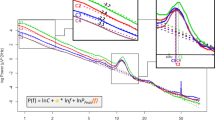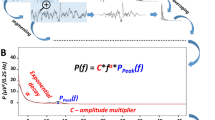Abstract
We tested the hypothesis of whether sleep electroencephalographic (EEG) signals of different time windows (164 s, 82 s, 41 s and 20.5 s) are in accordance with linear stochastic models. For this purpose we analyzed the all-night sleep electroencephalogram of a healthy subject and corresponding Gaussian-rescaled phase randomized surrogates with a battery of five nonlinear measures. The following nonlinear measures were implemented: largest Lyapunov exponent L1, correlation dimension D2, and the Green-Savit measures δ2, δ4 and δ6. The hypothesis of linear stochastic data was rejected with high statistical significance. L1 and D2 yielded the most pronounced effects, while the Green-Savit measures were only partially successful in differentiating EEG epochs from the phase randomized surrogates. For L1 and D2 the efficiency of distinguishing EEG signals from linear stochastic data decreased with shortening of the time window. Altogether, our results indicate that EEG signals exhibit nonlinear elements and cannot completely be described by linear stochastic models.
Similar content being viewed by others
References
Achermann P, Hartmann R, Gunzinger A, Guggenbuhl W, Borbély AA (1994) All night sleep EEG and artificial stochastic control signals have similar correlation dimensions. Electroencephalogr Clin Neurophysiol 90:384–387
Aihara K, Matsumoto G (1986) Chaotic oscillations and bifurcations in squid giant axons. In: Holden AV (ed) Chaos. Princeton, NJ, Princeton University Press, pp 257–270
Basar E (ed) (1990) Chaos in brain function. Springer, Berlin Heidelberg New York
Fell J, Beckmann P (1994) Resonance like phenomena in Lyapunov-calculations from data reconstructed by the time-delay-method. Phys Lett A 190:172–176
Fell J, Röschke J (1994) Nonlinear dynamical aspects of the human sleep EEG. Int J Neurosci 76:109–129
Fell J, Röschke J, Beckmann P (1993) Deterministic chaos and the first positive Lyapunov-exponent: a nonlinear analysis of the human electroencephalogram during sleep. Biol Cybern 69:139–146
Frank GW, Lookman T, Nerenberg MAH, Essex C, Lemieux J, Blume W (1990) Chaotic time series analyses of epileptic seizures. Physica D 46:427–438
Freeman WJ (1987) Simulation of chaotic EEG patterns with a dynamic model of the olfactory system. Biol Cybern 56:139–150
Glass L, Kaplan DT, Lewis JE (1993) Tests for deterministic dynamics in real and model neural networks. In: Jansen B, Brandt M (eds) Nonlinear dynamical analysis of the EEG. World Scientific, Singapore, pp 233–249
Grassberger P, Procaccia I (1983) Measuring the strangeness of strange attractors. Physica D 9:189–208
Grassberger P, Schreiber T, Schaffrath C (1991) Nonlinear time sequence analysis. Int J Bifurcation Chaos 1:521–547
Green ML, Savit R (1991) Dependent variables in broad band continuous time series. Physica D 50:521–544
Holden AV, Winlow W, Haydon PG (1982) The induction of periodic and chaotic activity in a molluscan neurone. Biol Cybern 43:169–173
Iasemidis LD, Sackellares JC, Savit RS (1993) Quantification of hidden time dependencies in the EEG within the framework of nonlinear dynamics. In: Jansen B, Brandt M (eds) Nonlinear dynamical analysis of the EEG. World Scientific, Singapore, pp 30–48
Kaplan DT, Glass L (1992) Direct test for determinism in a time series. Phys Rev Lett 68:427–430
Lutzenberger W, Birbaumer N, Flor H, Rockstroh B, Elbert T (1992) Dimensional analysis of the human EEG and intelligence. Neurosci Lett 143:10–14
Palus (1993) Testing for nonlinearity in the EEG. In: Jansen B, Brandt M (eds) Nonlinear dynamical analysis of the EEG. World Scientific, Singapore, pp 100–115
Pijn JP, Van Neerven J, Noest A, Lopes da Silva FH (1991) Chaos or noise in EEG signals: dependence on state and brain site. Electroencephalogr Clin Neurophysiol 79:371–381
Prichard D, Theiler J (1994) Generating surrogate data for time series with several simultaneously measured variables. Phys Rev Lett 73:951–954
Pritchard WS, Duke DW (1992) Measuring chaos in the brain: a tutorial review of nonlinear dynamical EEG analysis. Int J Neurosci 67:31–80
Pritchard WS, Duke DW, Coburn KL, Moore NC, Tucker KA, Jann MW, Hostetler RM (1994) EEG-based, neural-net predictive classification of Alzheimer's disease versus control subjects is augmented by non-linear EEG measures. Electroencephalogr Clin Neurophysiol 91:118–130
Pritchard WS, Duke DW, Krieble KK (1995) Dimensional analysis of resting human EEG. II. Surrogate-data testing indicates non-linearity but not low-dimensional chaos. Psychophysiology 32:486–491
Rapp PE, Albano AM, Zimmerman ID, Jiménez-Montaño MA (1994) Phase-randomized surrogates can produce spurious identifications of non-random structure. Phys Lett A 192:27–33
Rechtschaffen A, Kales A (1968) A manual of standardized terminology, technics and scoring system for sleep stages of human subjects. Public Health Service, NIH publication no. 204. US Government Printing Office, Washington, DC
Rombouts SARB, Keunen RWM, Stam CJ (1995) Investigation on nonlinear structure in multichannel EEG. Phys Lett A 202:352–358
Röschke J, Aldenhoff JB (1993) Estimation of the dimensionality of sleep-EEG data in schizophrenics. Eur Arch Psychiatr Clin Neurosci 242:191–196
Röschke J, Mann K, Fell J (1994) Nonlinear EEG dynamics during sleep in depression and schizophrenia. Int J Neurosci 75:271–284
Röschke J, Fell J, Beckmann P (1995) A nonlinear analysis of sleep EEG data in schizophrenia: calculation of the principal Lyapunov-exponent. Psychiatr Res 56:257–269
Sheinkman J, LeBaron B (1989) Nonlinear dynamics and stock returns. J Business 62:311
Soong ACK, Stuart CIJM (1989) Evidence of chaotic dynamics underlying the human alpha-rhythm electroencephalogram. Biol Cybern 62:55–62
Takens F (1981) Detecting strange attractors in turbulence. Lect Notes Math 898:366–381
Theiler J (1986) Spurious dimension from correlation algorithms applied to limited time-series data. Phys Rev A 34:2427–2432
Theiler J, Eubank S, Longtin A, Galdrikian B, Farmer JD (1992) Testing for nonlinearity in time series: the method of surrogate data. Physica D 58:77–94
Wolf A, Swift JB, Swinney HL, Vastano JA (1985) Determining Lyapunov exponents from a time series. Physica D 16:285–317
Wolf A, Bessoir T (1991) Diagnosing chaos in the space circle. Physica D 50:239–258
Author information
Authors and Affiliations
Rights and permissions
About this article
Cite this article
Fell, J., Röschke, J. & Schäffner, C. Surrogate data analysis of sleep electroencephalograms reveals evidence for nonlinearity. Biol. Cybern. 75, 85–92 (1996). https://doi.org/10.1007/BF00238742
Received:
Accepted:
Issue Date:
DOI: https://doi.org/10.1007/BF00238742




